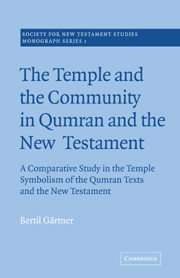 The Temple and the Community in Qumran and the New Testament
The Temple and the Community in Qumran and the New Testament Book contents
- Frontmatter
- Contents
- List of Abbreviations
- Introduction
- AUTHOR'S NOTE
- I The Priesthood and the Jerusalem Temple
- II The Temple Priests and Qumran
- III The ‘New Temple’ in Qumran
- IV Temple Symbolism in the New Testament
- V Temple Symbolism and Christology, Collective and Individual
- Bibliography
- Index of Authors
- Index of Subjects
- Index of Passages Quoted
II - The Temple Priests and Qumran
Published online by Cambridge University Press: 26 February 2010
- Frontmatter
- Contents
- List of Abbreviations
- Introduction
- AUTHOR'S NOTE
- I The Priesthood and the Jerusalem Temple
- II The Temple Priests and Qumran
- III The ‘New Temple’ in Qumran
- IV Temple Symbolism in the New Testament
- V Temple Symbolism and Christology, Collective and Individual
- Bibliography
- Index of Authors
- Index of Subjects
- Index of Passages Quoted
Summary
THE theology of the Qumran community was largely concentrated on establishing that degree of holiness which was accounted necessary for winning God's favour in the last days. This they believed could be attained by the detailed observance of the rules and regulations of the Law. By this means they won a renewal of the covenant, and stood out as the pure and holy Israel, the elect out of the ‘official’ Israel. This concentration on sanctification, expressed in a multitude of regulations for ceremonial purity and an intense exclusiveness, was not merely an expression of personal piety, but is to be seen against the background of the priestly office as we have described it. There is a striking correspondence between the rules binding the priests in their holy office and the methods used by the Qumran community in order to build up their organization and preserve their holiness.
The Qumran community was made up of priests and laymen, the former having considerably greater authority. These were known as the ‘sons of Zadok’ or the ‘sons of Aaron’. The latter seems to have been a fairly common priestly title, setting the priests apart from ‘Israel’, the community; the expression ‘the sons of Zadok, the priests’, on the other hand, has polemical overtones, and implies the superiority of the class from which the high priest was drawn. In the history of the Qumran community it was told that the Teacher of Righteousness, who was of the priestly line, entered into conflict with a certain man who carried out the duties of a priest without belonging to the family of Zadok.
- Type
- Chapter
- Information
- The Temple and the Community in Qumran and the New TestamentA Comparative Study in the Temple Symbolism of the Qumran Texts and the New Testament, pp. 4 - 15Publisher: Cambridge University PressPrint publication year: 1965
- 1
- Cited by


